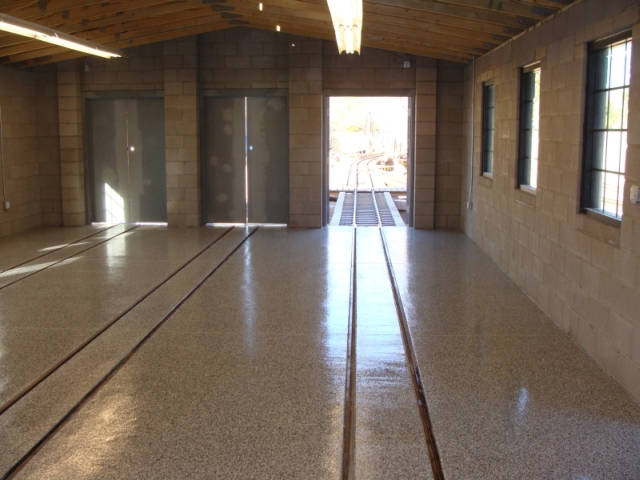
|
This page of the website follows projects taking place at the Arizona and Pacific Railroad and gives visitors a chance to see the progress that was made in 2008.
2/09/08
Significant progress was made on our enginehouse project in January. Our second electrical inspection planned
for the last week of December was delayed by the holidays. That inspection as well as our “Service Section”
inspection and “Final” took place the first two weeks of January and went very smoothly. The electrical is
complete and it sure is nice having service out there without dragging 200 feet of extension cords!
The next project we tackled was an epoxy floor finish for the enginehouse. As most train owners will tell you,
each engine has her own personality, idiosyncracies and leaks. There is a practical limit to eliminating every
leak so I wanted to coat the floor such that cleaning up afterward is as easy as possible. We met with several
vendors and made our material, color and contractor selection. We were initially told it would take four days to
complete the floor. Well a cold front hit us the same day they started on the floor. This is the desert and can
get much colder than many people realize. We had night time temperatures in the low and mid twenties several days
in a row with highs in the low fifties. This meant instead of applying a coat of material first thing in the morning
and another late in the day after the earlier coat had cured, only one coat per day could be applied. It took eight
days to complete the floor, but was worth the wait. It looks good, has texture to keep it from getting slippery and
best of all oil, hydraulic fluid etc. wipes right off.

|
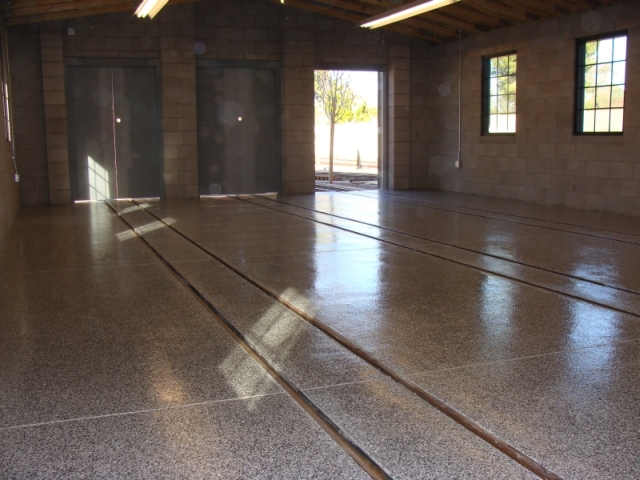
|
2/15/08
Last week, I stated I would try to get a few photos of our progress on the rock work posted. Well,
as promised, here are a few photos of the rock work on the west and the south sides of the enginehouse.
The columns, arches above the doors and the trim around our logo took seemingly forever, but add some
detail and character to the west face. The two large gooseneck light fixtures also contribute to the
look and put out a great deal of light. The soldier course window sills, the window trim and the length
of the building were the main challenges on the south side. We have the two toughest sides done and have
started on both the east and north sides of the building. We are probably about sixty percent finished
with the rock work overall. We wanted a really distinctive rock look for the enginehouse and we definitely
have achieved that, but to quote a line out of one of the old Rocky movies, “Ain’t gonna be no rematch”
- read no more stone buildings for me after this one is finished.

|
3/29/08
There are still lots of things to do on the interior of the engine house from finish carpentry to mounting
fire extinguishers, but we finally put the finishing touches on the stone work this week. Did I mention how
excited I am that we are done cutting and fitting stone? We also finished the final coat of paint on the doors,
door jambs, arch panels and the hand railing. The doors are back up and we have a good start on getting the balance
of the hardware installed. We have already run the wiring to tie the security system in the engine house into the
one already in place in the superintendent’s house. After the door hardware is all in place in the next week or
so, we can get the sensors hooked up and won’t be too far from moving our equipment into its new home.
We still have a bit of finish work on the exterior to complete with the two logo signs that have to come down and
have some finish grinding and the rings and letters welded in place. Plenty of seam sealer, a few good coats of
paint and a nice layer of clear coat later and they will be ready to reinstall. We also have a stone pedestal which
needs finished to display our harp switch stand.
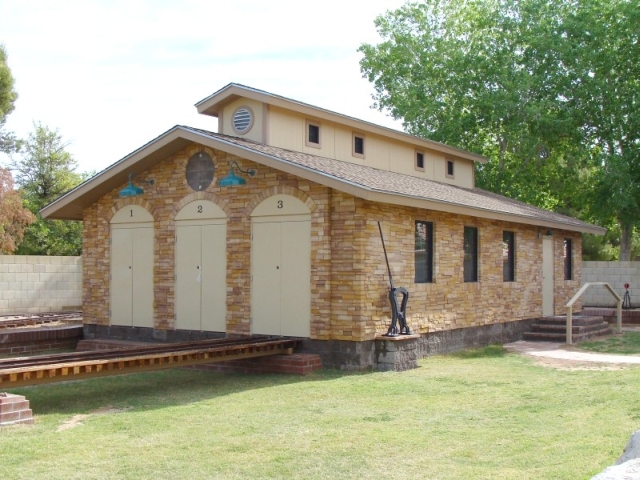
|
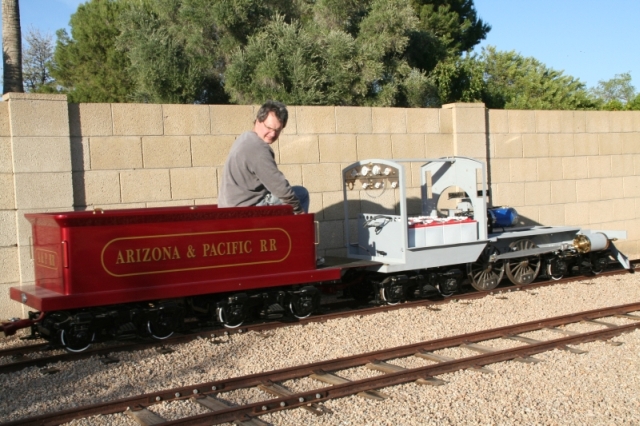
|
4/05/08
We made some progress on the engine house in the last week. The logo signs on the building have been
completed and installed. The pedestal for our harp switch stand has been completed and the switchstand is
in place – forgot how heavy that thing is. The four interior fire extinquishers have been mounted. Although
a great deal of door hardware awaits mounting, the dead bolts are finally in place and the doors can be locked.
The main logo sign has been completed and mounted in its frame; we still need to paint and mount the lower sway
bracket. Now the engine house focus can shift to the interior and we will get started on the balance of the
finish work.

|

|

|

|
5/24/08
We're making progress at the Arizona and Pacific Railroad despite the crazy weather. Last Sunday it
was 109°F while we were working on the walkway to the loading platform. Dave's job had him in Dallas
on Thursday and when he returned it was 55°F and there was an inch of rain at his house (~15% of our annual rainfall).
Weather permitting we'll have an update soon.
I didn't get any photos at the A & P RR last weekend but I did visit the Forest Park Miniature Railroad
in Fort Worth while I was in Texas this week.
You can read the spotlight article of my trip here: Forest Park Miniature Railroad
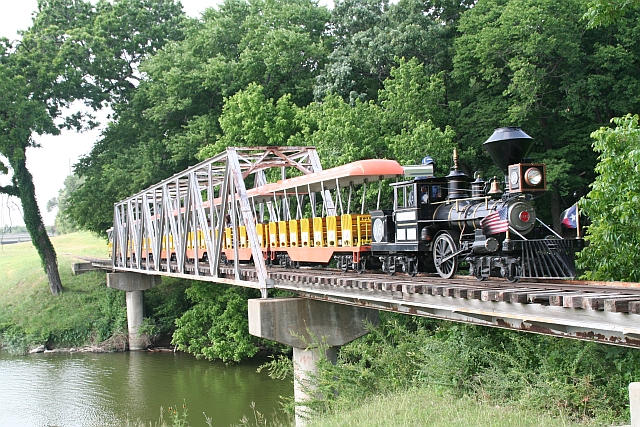
|
5/10/08
We shot some video of the Arizona and Pacific that you can see by clicking here:
Arizona and Pacific Video Page
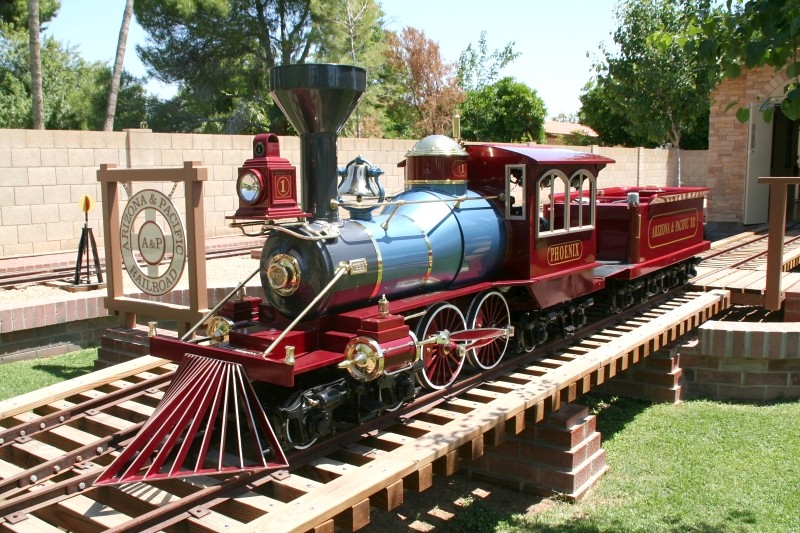
|
5/05/08
We have been working on several projects in the four weeks since the last update. We finally got the telephone,
clock and thermometer mounted in the engine house. The stereo and TV shelf is mounted in the corner so I can work
on trains and have something to listen to in the back ground. We also got the A & P RR train schedule board up on
the wall. We bought a new craftsman toolbox and moved many of the tools used exclusively on the trains from the
garage into the new box in the engine house. We also mounted our grand scales railroad builders plate display in
the new engine house. We have several original and a couple reproduction builders plates from past and present
manufacturers of 15 – 24 inch gauge park locomotives on display. Among our favorites are an original Sandley and
Cagney and a reproduction Chance plate. We have plenty of room for more and are always looking to add to the collection…

|
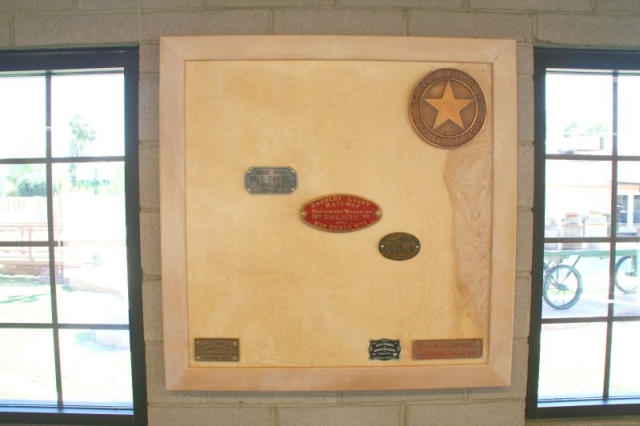
|
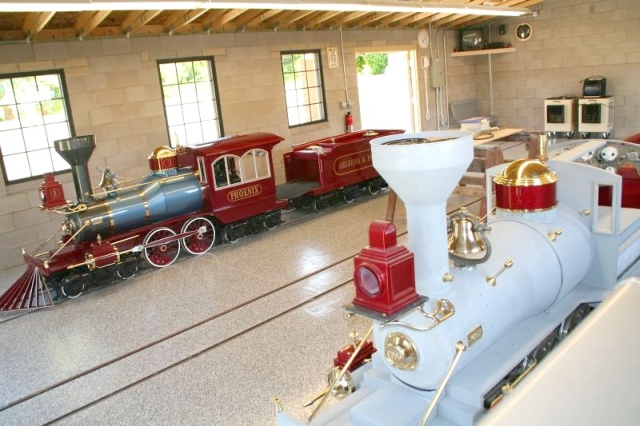
|
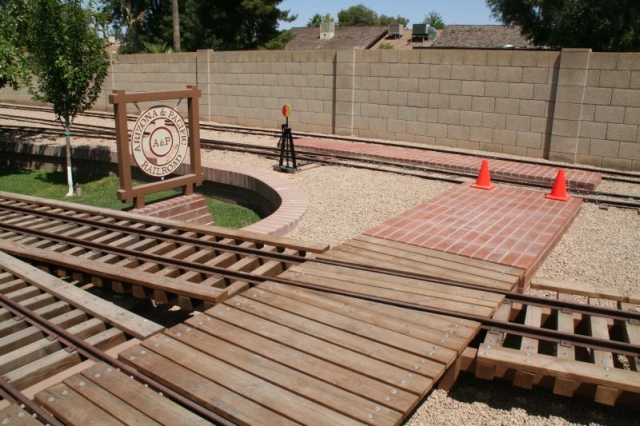
|
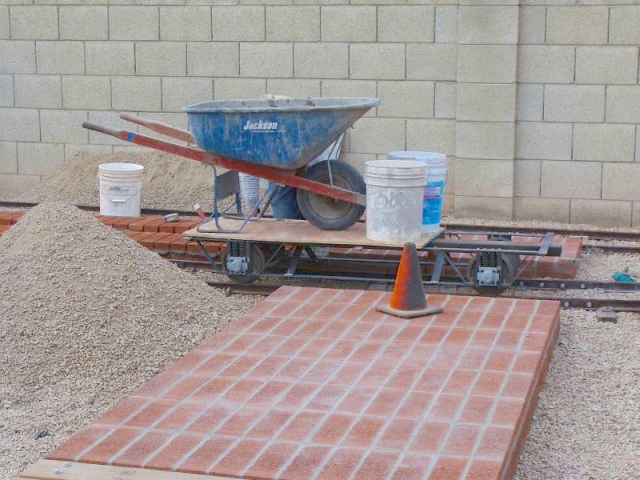
|
6/7/08
Fitting and mounting the various brass components to engine No. 2 continues. We made three custom brass bands for the boiler
and are still adjusting our custom made stanchions and handrails. We have quite a way to go, but are continuing to make
progress.
We completed the last of the wood planking on our pedestrian walkway which allows guests to walk comfortably and safely across
the three sets of tracks on their way to reaching our primary loading area. The 16 foot long by 33 inch wide loading platform
was finished and discussed in a previous update.
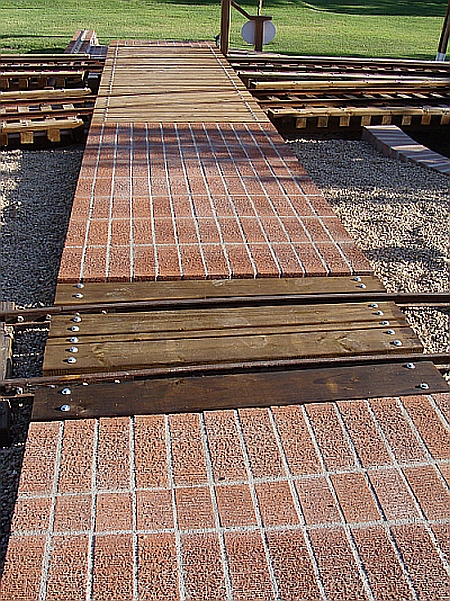
|

|

|

|
6/22/08
Well, summer has definitely arrived on the Arizona and Pacific. Saturday the 21st was the first full day of summer and
the thermometer in the shade on the back patio read 118°F at 4:30 and climbed to 119°F before heading back down. This is the
desert and it is supposed to be hot this time of year, but anything over 110°F and it is tough to stay motivated to get
much accomplished out there. The heat pulls the water and energy right out of you.

|
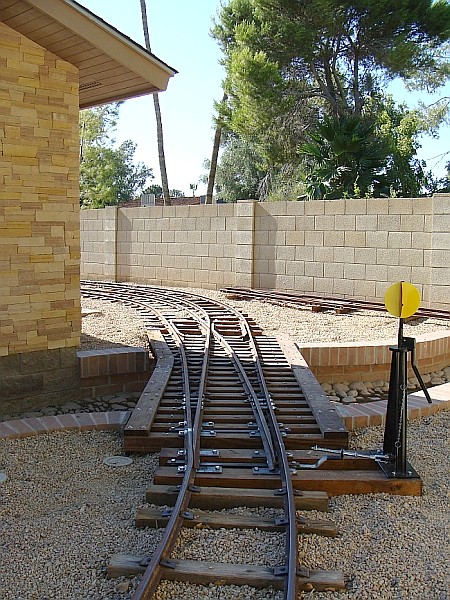
|
7/12/08
Two weeks ago, we finished the bending and gauging on the final section of rail in our new spur. The spur is 120 feet long.
The final ballast work remains to be completed, but the rail and tie work is finally done. We also have a couple of minor
adjustments to make on our new switch and that will happen later this month.
Well, the temperature plummeted to 110°F last weekend so Dave and I seized the opportunity to do some track work. We dug out
twenty-five of the ties we originally set in 1995 and replaced them with new ties. The problem here isn’t water causing the ties to
deteriorate, it is the dryness and the heat. The ties check, splinter and crack after several years cooking in the hot gravel ballast.
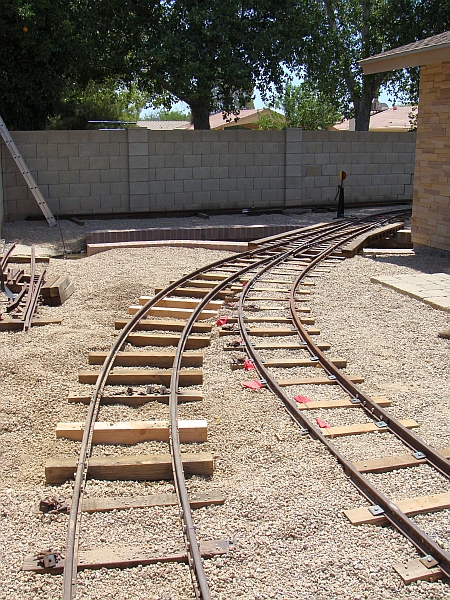
|
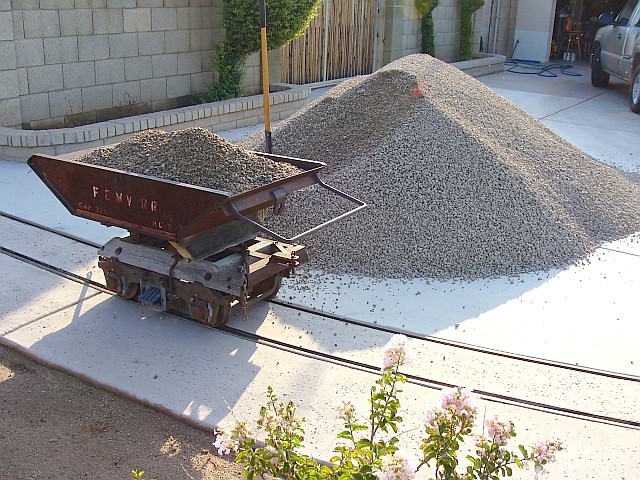
|
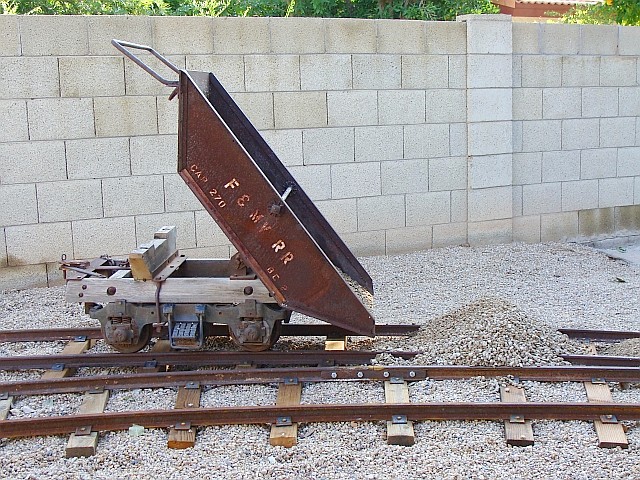
|
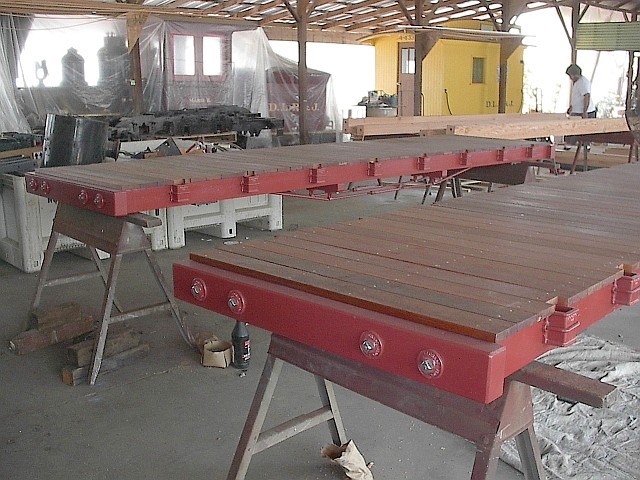
|

|
8/23/08
We just completed editing last week's video footage taken by remote controlled airplane. You can check out the finished
video by clicking here:
Arizona and Pacific Video Page. It's the second video on the page. We also managed to get a few screen captures that
are shown below.
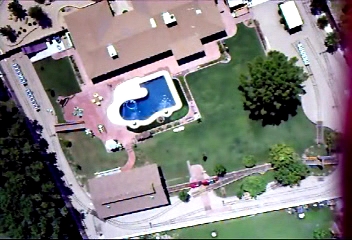
|

|
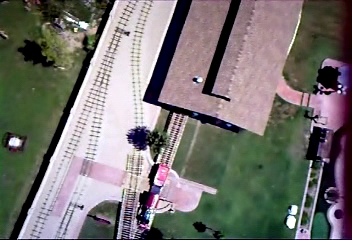
|
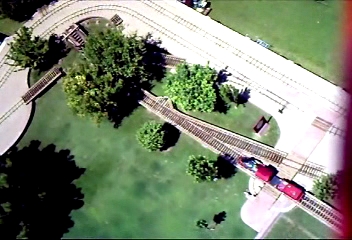
|
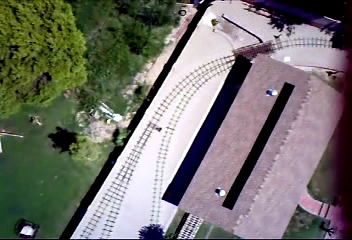
|
8/16/08
A friend of Dave's named Jerry Carter brought his remote control airplane to the A&P Railroad
today. Jerry's RC plane has a video camera attached and he shot a few minutes of video as he flew
over the Arizona and Pacific Railroad. After we get the video and have a chance to edit it we'll
post it on this site.
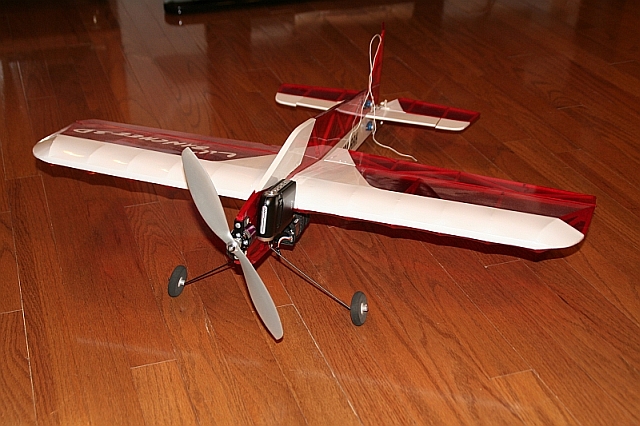
|
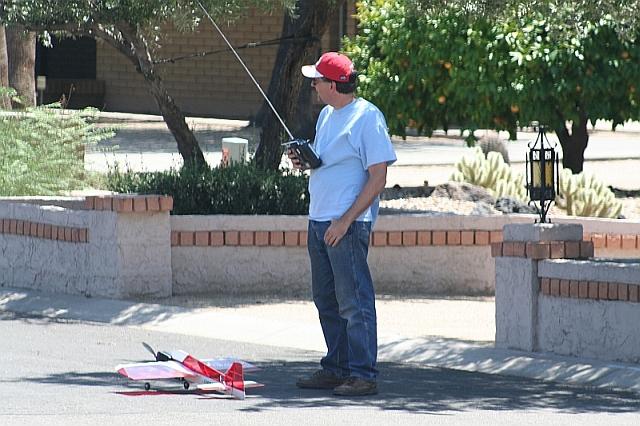
|

|

|
10/08/08
It has been a while since I updated the projects page so I figured you deserved an explanation of what
I have been up to the last several weeks. I started a magazine entitled Large-Scale Railroading which
in many ways is a celebration of rideable scale railroads. If you think you might have an interest in
subscribing, check out the link to that website (click on photo below). The inaugural issue ships the week
of October 13. It isn’t a big publishing conglomerate, just me with some help from some friends, but I’m happy
with the first issue and hope it will get bigger and better as we go along. The first issue is 56 pages. If you
like my writing style and sense of humor here, you will probably enjoy the magazine.
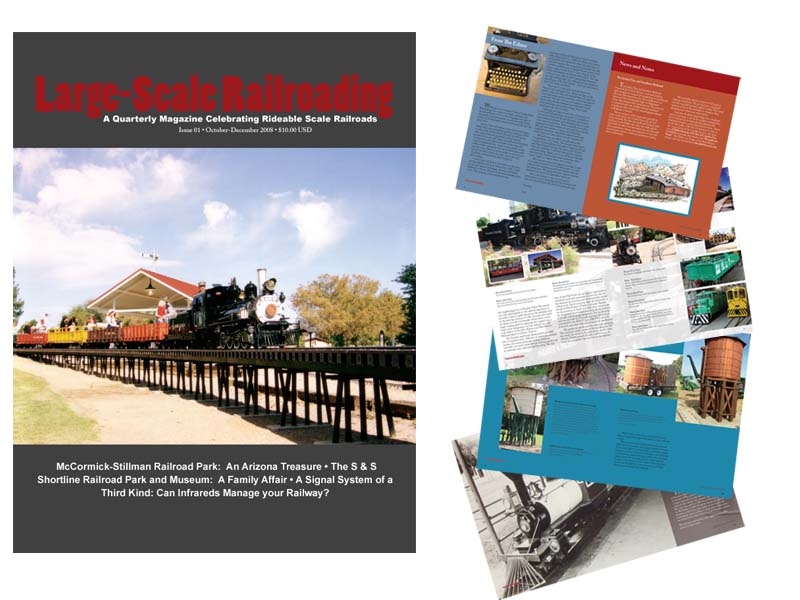
I am in the midst of rebuilding 10 Allan Herschell coach trucks, two power trucks and designing and building four arch-bar trucks utilizing Allan Herschell wheels and axles. These AH and MTC trucks were all purchased very used many years ago from a variety of sources and have been stored all this time and I am finally getting to them. The trucks were completely disassembled and bead blasted. The leaf springs were checked for condition and alignment and the plank bearings were checked for wear. Wheels and axles were replaced as needed. The bearings and races were all cleaned and checked for wear. About 60% of the bearings and races were still in great shape and just needed cleaned and fresh grease; the balance were retired. All the seals were replaced. The wheels and axle assemblies and the frames were painted separately and then touched up after assembly.
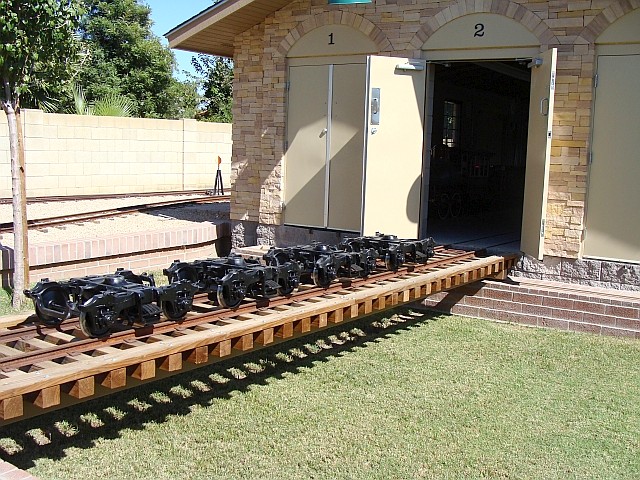
|
Phase two of the AH coach truck rebuild process will start in November when I start to clean, straighten, paint and hang brake rigging. I also will be building 12 brake line manifolds as the originals were too mangled to be reused. Then it is on to brake shoes and vacuum canisters… - no, there won’t be “film at eleven”, but I will keep plugging away.
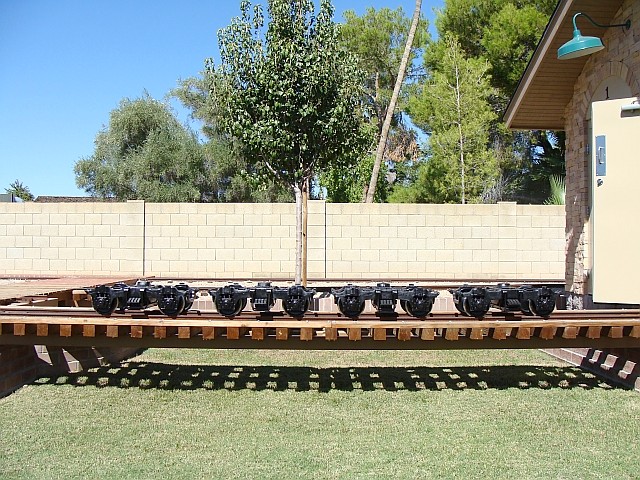
|
The two power trucks are apart and the journal boxes have been rebuilt. The bearings and seals for the gear boxes are now on site and I hope to have these power trucks done early in 09 as time permits.

|
I am also about half way along in building two small (4 foot long and 6 foot long) MOW flat cars that can be used to haul tools and other materials back and forth to assist in maintenance and new construction. The MOW cars also utilize Herschell wheels and axles, but not its trucks.
There are three major reasons why I have tried to build as much of our rolling stock as possible out of MTC/ Hershell wheels and axles. One, it is technology proven over time. Two, the bearings, seals, axles, wheels and other components are the same on most of our equipment thus I know the parts are available and the parts shelf doesn’t have hundreds of different parts. Okay, it does have hundreds of different parts, but not thousands… Three, mixing and matching multiple wheels and flanges can make for an interesting afternoon.
The Arizona and Pacific Railroad utilizes cast frogs of the Miniature Train Company or Allen Herschell variety on all but one of its switches. The frogs are exceptionally smooth when MTC and AH wheels or wheels which follow those wheel and flange profiles are used. Wider and deeper flanges as well as taller wheels make for a rough ride through the frogs and frequently the ride gets even rougher through the gravel… The real “fun” starts getting the wheels back on the rails.

|
Progress continues on the “Sandusky”. The plumbing for the gauges is complete, some additional wiring is finished and a number of “odds and ends” have been finalized. The headlight sealed beam and retaining ring have been installed. You would think that would be an easy task – well not so much. The headlight pocket was originally designed for a 6 volt sealed beam in a style which was slightly thinner. Problems arose when the retaining ring grove was not accessible with the new 12 volt sealed beam in the pocket. Lots of adjustments, modifications and hours later, the headlight and retaining ring are in place and look pretty good. The “to do” list on No. 2 is getting shorter.
Our four arch bar trucks which also utilize AH/MTC wheels and axles are finally nearing completion. They will go under our two gondolas built by Hillcrest shops. The cars will get their “christening” the weekend of October 11 and 12 at the Reedley Railfest held at the Hillcrest Shops in California. They were a couple of cars short for their festival so we volunteered our cars which will be rolling on their trucks for the weekend. We plan to have the cars here by the end of the month, so I better quit typing and get going and get some more work done on the trucks. Have a great weekend everybody.
10/31/08
Several months ago, I contracted with Sean and Melissa Bautista at Hillcrest shops in Reedley, California
to build us two gondola cars. They are always busy building or restoring cars and engines, laying rail on their
railroad or someone else’s and working on various construction projects around their railroad – not to mention
their real jobs. There is always a waiting list for their equipment, but it never disappoints. Our cars were completed
the end of September and we loaned them to the Hillcrest and Wahtoke Railroad for use at their Reedley Railfest held the
weekend of October 11 and 12. They made their public debut on a train lead by the beautiful engine named the “Sonoma” at
the popular and well attended festival.
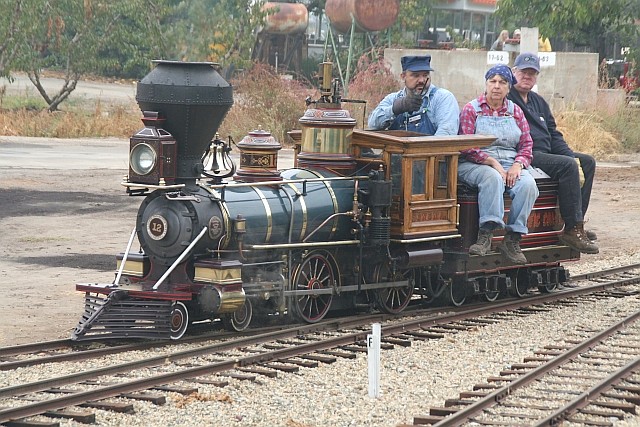
|

|

|
I headed off to northern California bright and early at 5 a.m. (okay not bright, but it was early) on the morning of October 25
with a 22 foot trailer in tow to retrieve our two gons at Hillcrest in Reedley and to pick up a “project” B unit for our G-16 from
our friends at the Panella Pacific Railroad just south of Lodi, CA. Prior to this trip, I thought the interstate highways in Arizona
were in need of some resurfacing and repair work - and they are… Even traveling at only 55mph through southern California, I think
I may have rattled loose a couple of teeth fillings… Unbelievable roads!

|
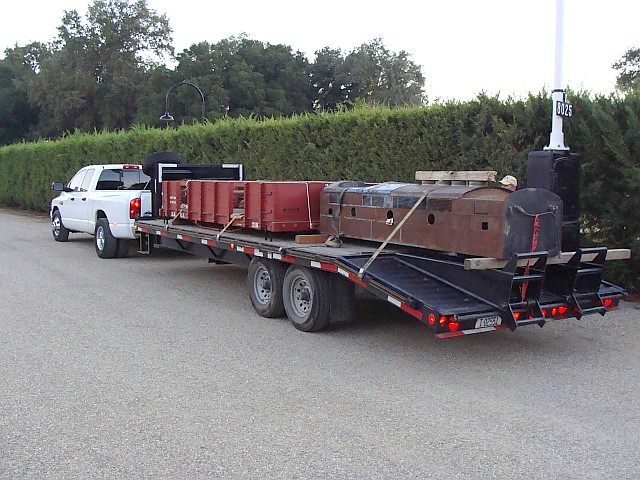
|
We did get some thumbs-up on the way back from other motorists and props from a really cute gal at a gas pump outside Newberry Springs,
California who knew the B unit was a Miniature Train Company product. How unbelievable is that? No, not that she was really cute and
speaking with me, but that she knew the sheet metal was MTC when most of my railroad friends wouldn’t even have known that… I was so
surprised and stunned, that before I could even ask how she knew it was MTC equipment she and her friend were back in their truck and
driving off…

|
Anyway, after 16 hours of windshield time Saturday followed by 16 more on Sunday, the gondolas and the B unit were unloaded here in
Peoria. Years ago, traveling 1600 miles and 32 hours in two days was an adventure and fun – maybe not so much in my fifties…
It feels good to be home.
I planned to have the arch bar trucks that will go under these gons completed by now, but still have some final details and
paint to complete. I will get after that in the next couple of weeks. We should have the gons on the rail and operating here by
Thanksgiving – at least that’s the plan. The B unit will go into storage for now.
On another topic, we finished wiring the instrument panel on our S-16 No. 2 the “Sandusky”. The switches for the headlight,
dash lights and tender back up light were installed. The sockets were wired and everything was tested and works fine.
We are currently working on the sound system.
11/23/08
The first week the new gons were here in Peoria, they spent on blocks and under tarps in the driveway. The following
weekend we placed temporary trucks under them and got them moved into the engine house where they were again placed
on blocks while we worked to complete the arch bar trucks.
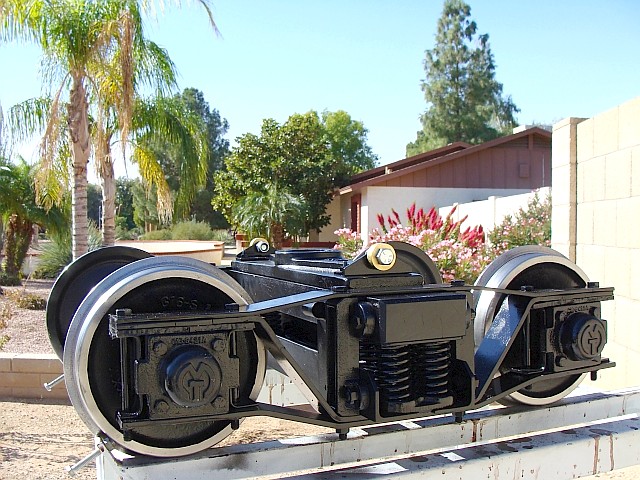
|
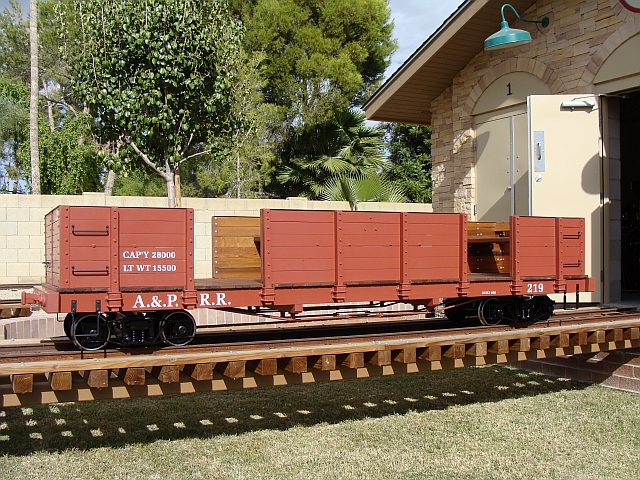
|

|

|
12/26/08
The Saturday and Sunday after Thanksgiving was a track work weekend. There were four of us
on Saturday and five on Sunday. It was a long, hard weekend, but we did get a lot accomplished.
We cut several pieces of rail and increased the space between rail ends to better allow for expansion
in the summer, dug out and replaced several ties, replaced the original lag screws in areas near the
front lawn with galvanized lag screws and re-ballasted and re-leveled some areas. We still have several
more ties that will get galvanized screws after the first of the year, but our track in general should
be in great shape for several months.
In our last update we shared we had our new arch bar trucks under our two new gons. Prior to positioning
them behind No. 1 and No. 2, we pushed them around the entire layout in both directions to make sure the
trucks were happy and that we had plenty of clearance with switch stands. The cars are 10 inches wider
than the standard S-16 cars and I had calculated that before ordering them, but a slow speed field test
is always a good idea anyway. They fit and roll beautifully.
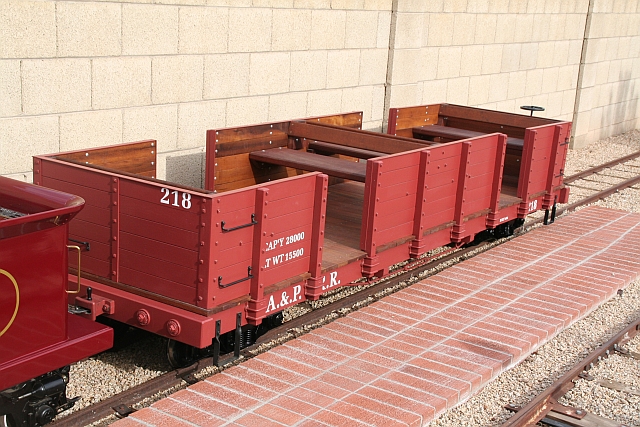
|
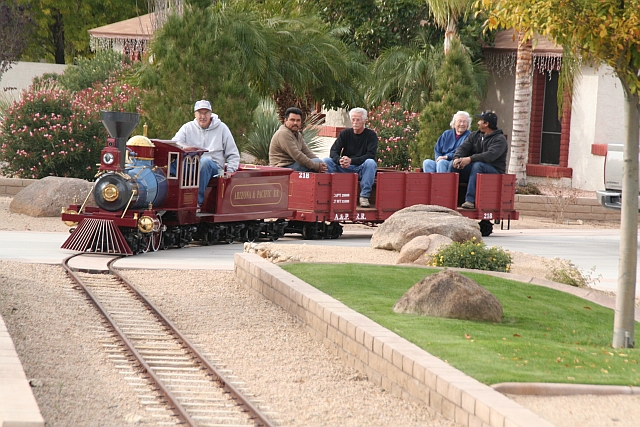
|

|

|
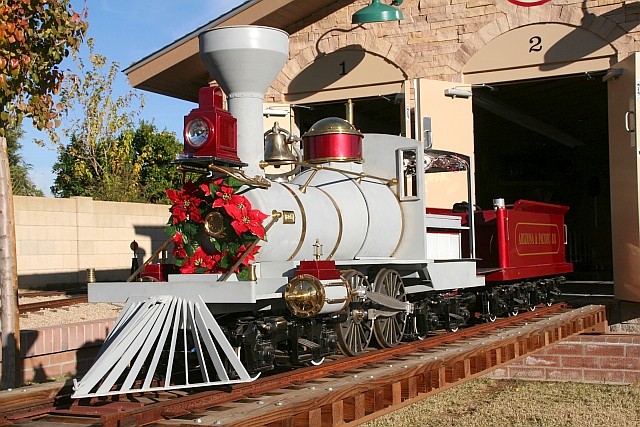
|
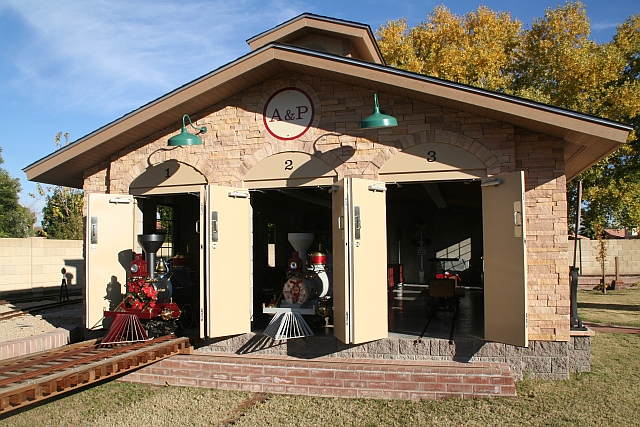
|